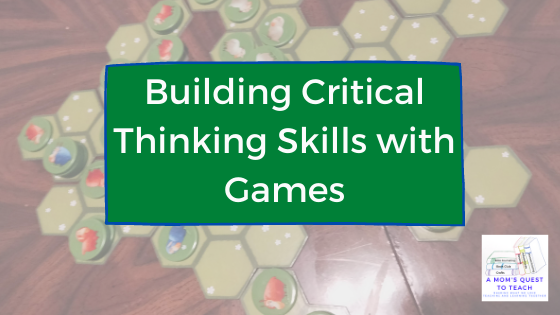I received a COMPLIMENTARY copy of Battle Sheep from Timberdoodle in exchange for my honest opinion. I was not
required to write a positive review, nor was I compensated in any other way.
This post contains tracking links. For more information, please see my Terms
of Use and Disclosure Policy page. Thank you.
Building critical thinking skills is very important. As parents and homeschoolers, we want our children to be able to think through things critically, be able to access and understand a variety of reading materials, and be able to solve problems on their own.
There are many ways we can help our children develop their ability to think critically. We want them to practice:
- Observation skills
- Analytical skills
- Inference skills
- Problem-solving skills
- Communication skills or applying what they learn as they think critically
One of our favorite ways to encourage critical thinking is through games like
Battle Sheep. This fun, easy-to-learn (but difficult-to-master) game is part of the
Third Grade Timberdoodle Curriculum Kit. We were blessed with the opportunity to review it in our homeschool and Battle Sheep has quickly become a hit with our younger son.
What is Battle Sheep?
"Battle Sheep: Flock to Greener Pastures" is a Blue Orange game for two to four players of ages 7 to adult. Players are in charge of a sheep stack, and they attempt, through play, to gain control of all Farmer Pat's pastures. Before play starts, they create the board by placing each of their four pasture boards. Each hexagon on the pasture board represents one pasture, and each pasture board contains four hexagons (resulting in four pastures per pasture board piece).
Once all the pasture boards have been placed, players pick their starting point to place their stack of 16 sheep. From this point, each player moves their sheep to attempt to take over the pasture lands. When moving sheep, the stack is split into two stacks. Each stack must contain at least one sheep. The original stack stays in place, and the new stack moves as far as it can in a straight line.
It is in the moving of the stacks of sheep where players need to use critical thinking skills. As you want to have the most sheep on each pasture board, it is important to spread your sheep throughout the game board. It is also important not to allow your sheep stack to be blocked by yourself or the other players. As you cannot jump over or combine stacks, you want to make sure you have many straight lines available for movement.
What is in the Box?
Battle Sheep has everything you need to play packed into a sturdy box. The 64 sheep chips (16 of each color - blue, white, black, and red) and 16 heavy, cardboard pasture tiles. Everyone in our family was impressed by the quality of the materials. In fact, our 18-year-old said, "wow, these chips are high quality." When you are done playing, everything fits neatly back in the box.
Building Critical Thinking Skills
The first time we played, it was just my husband, our eight-year-old son, and myself. We worked through the instructions, looked at the back of the box to see what a game in progress looks like, and then dove in for our first play through. There were a few instances where we needed to consult the rules again, but, in general, I found Battle Sheep easy to figure out. Personally, I jumped right into our first game without putting too much thought into where I wanted to start my sheep stack. This was a mistake, I quickly discovered. Players really need to think in advance of their steps to ensure that they are able to move their sheep in multiple ways.
After our first game, our son said, "I already know how I want to play the game differently next time." I love the fact that he was thinking through the current game and building a strategy for future games, too. To me, this means that Battle Sheep is not just a game that one plays, enjoys, and then puts back on the shelf. It is a game that builds critical thinking skills. Battle Sheep helps one think differently about gameplay and how to implement different strategies.

In addition to building critical thinking skills, Battle Sheep can also help foster healthy competition. After all, one person is going to win. Teaching our children how to be gracious winners and accept losses is important to our family. Battle Sheep can help in this area, too. As the game only takes about 15 minutes (or as long as everyone takes planning out their moves), you can play it multiple times in one sitting. Playing it over and over in a short amount of time helps work through new ideas for gaining more pasture land.
I think we would all recommend Battle Sheep. The recommended starting age of seven seems to be right on target. I think it would be a welcome addition to many a homeschool's game shelves. Our son said it is his new favorite game, and he has asked to play it on a regular basis. This makes Battle Sheep a win for our homeschooling family!
If you are looking for another game from Blue Orange, you might want to give
Gobblet Gobblers a try!






This game looks awesome! It’s great to find new resources for critical thinking. Great review - Thank You!
ReplyDelete